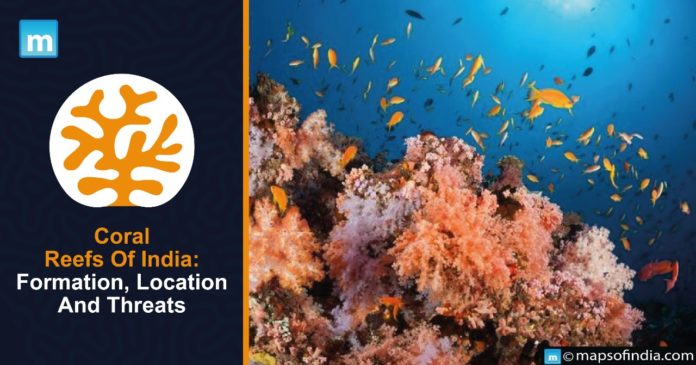Coral reefs, one of the planet’s oldest and most complex ecosystems, have proven essential to the survival of life in the seas. Corals prosper in the Indian Ocean because of India’s warm, tropical climate. These corals not only provide a haven for a diverse environment, but they also safeguard coasts from erosion.
How do they develop?
Coral polyps are small, fleshy sea anemones in subtropical and tropical oceans and seas. They dwell in shallow waters with a symbiotic association with tiny algae called Zooxanthellae. These algae possess photosynthetic skills that supply compounds rich in carbon to coral polyps and deliver them with energy. In exchange, the polyps guard the Zooxanthellae.
Coral reefs emerge when free-moving coral larvae bind to rock layers or hard surfaces near coasts. This process is carried out with the assistance of numerous additional processes, such as sedimentation, compaction, cementation, and solidification of coral polyp skeletons.
Where can you find coral reefs in India?
India has about 7,517 kilometres of coastline. However, only 6,100 kilometres are on the mainland. India has three basic types of coral reefs: fringing, barrier, and atoll. Coral reefs may be found in various locations in India, notably the Gulf of Kutch, Palk Bay, the Andaman and Nicobar Islands, the Gulf of Mannar, and the Lakshadweep Islands. The Gulf of Kutch in Gujarat features some of the world’s northern reefs.
Coral reef patches may also be found at Ratnagiri and Redi in south Bombay and the Gaveshani Bank in Mangalore’s west. Moreover, corals run parallel to the coastline from Quilon on the Malabar coast to Enayem in Tamil Nadu. Corals abound on the east coast between Parangipettai and Pondicherry. In addition, the Lakshadweep Islands and the Andaman and Nicobar Islands are abundant in thriving corals for island ecosystems.
Coral reef varieties found in India
Fringing reefs
- Fringing reefs form near the continental shelf and stay adjacent to the coastline.
- A shallow lagoon separates these reefs from the coast.
- Reefs such as these are prevalent throughout the world.
Barrier reefs
- Offshore on the continental shelf, barrier reefs can be found. They normally run for some distance parallel to the beach. Between the beach and the barrier reef lies a deep and vast lagoon.
The atolls
- Atolls form along mid-ocean ridges. They are round or elliptical, bordered on all four sides by oceans, and feature shallow waters in the middle known as a lagoon.
What are the best environmental conditions for the growth of corals?
Certain conditions must be satisfied for coral reefs to develop in full bloom.
- Shallow water
- The surface that is semi-hard or hard
- Sediments free water
- Warm water (temperature~27 degrees)
- A plentiful supply of nutrients
What are the challenges that are driving corals to extinction?
Human actions provide a range of risks to coral reefs, either directly or indirectly. Scientists anticipate that by 2050, all coral reefs will suffer risks, with 75% experiencing high risk. Among these dangers are the following:
Climate change
- The oceans are becoming more acidic due to global warming, posing a threat to the coral ecology.
- Furthermore, glaciers are melting, causing sea levels to rise. Rising sea levels bury coral reefs and deprive them of sunshine, causing them to develop slowly.
Pollution in the seas
- Marine contamination in plastic waste and other activities has starved the corals. Coral reefs require air and room to survive.
- We may lose them sooner than we imagined because of increased levels of marine pollution.
Bleaching of Coral
- When the waters get warmer than the desired temperature, coral bleaching occurs.
- Corals become stressed due to their low-temperature tolerance and discharge symbiotic algae in reaction.
- When they run out of algae, they lose their life supply and cease to exist.




